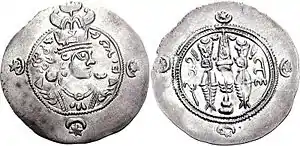632
Year 632 (DCXXXII) was a leap year starting on Wednesday (link will display the full calendar) of the Julian calendar. The denomination 632 for this year has been used since the early medieval period, when the Anno Domini calendar era became the prevalent method in Europe for naming years.
| Millennium: | 1st millennium |
|---|---|
| Centuries: | |
| Decades: | |
| Years: |
| 632 by topic |
|---|
| Leaders |
|
| Categories |
|
| Gregorian calendar | 632 DCXXXII |
| Ab urbe condita | 1385 |
| Armenian calendar | 81 ԹՎ ՁԱ |
| Assyrian calendar | 5382 |
| Balinese saka calendar | 553–554 |
| Bengali calendar | 39 |
| Berber calendar | 1582 |
| Buddhist calendar | 1176 |
| Burmese calendar | −6 |
| Byzantine calendar | 6140–6141 |
| Chinese calendar | 辛卯年 (Metal Rabbit) 3328 or 3268 — to — 壬辰年 (Water Dragon) 3329 or 3269 |
| Coptic calendar | 348–349 |
| Discordian calendar | 1798 |
| Ethiopian calendar | 624–625 |
| Hebrew calendar | 4392–4393 |
| Hindu calendars | |
| - Vikram Samvat | 688–689 |
| - Shaka Samvat | 553–554 |
| - Kali Yuga | 3732–3733 |
| Holocene calendar | 10632 |
| Iranian calendar | 10–11 |
| Islamic calendar | 10–11 |
| Japanese calendar | N/A |
| Javanese calendar | 522–523 |
| Julian calendar | 632 DCXXXII |
| Korean calendar | 2965 |
| Minguo calendar | 1280 before ROC 民前1280年 |
| Nanakshahi calendar | −836 |
| Seleucid era | 943/944 AG |
| Thai solar calendar | 1174–1175 |
| Tibetan calendar | 阴金兔年 (female Iron-Rabbit) 758 or 377 or −395 — to — 阳水龙年 (male Water-Dragon) 759 or 378 or −394 |

King Yazdegerd III of Persia (632–651)
Events
Arabia
- March 18 (approximate) – Muhammad makes his final sermon to the Muslims. It is believed by Shia to be the appointment of Ali ibn Abi Talib as his successor. The Imamah (Shia doctrine) of Ali Ibn Abi Talib, for the religious, spiritual and political leadership of the Ummah, begins.
- June 8 – Muhammad dies at Medina at the age of 61, after an illness and fever.
- June – Abu Bakr (also known as Abdallah ibn Uthman ibn Amir, better known by his Islamic laqab Al-Siddiq) becomes the Caliph.
- Ridda Wars: Abu Bakr launches a series of military campaigns against rebel Arabian tribes, to re-establish the power of the Rightly Guided Caliphs, and to secure Muhammad's legacy.
- September – Battle of Buzakha: An Islamic column (6,000 men) under Khalid ibn al-Walid defeats the Apostate rebels under Tulayha, near Ha'il (Saudi Arabia).
- December – Battle of Aqraba: The Muslim forces of Abu Bakr defeat the Apostate rebels (40,000 men) under Musaylimah, on the plain of Aqraba.
Europe
- April 8 – King Charibert II is assassinated at Blaye (Gironde), (possibly on orders of his half-brother Dagobert I), along with his infant son. Dagobert I claims Aquitaine and Gascony, becoming the most powerful Merovingian king in the West.
- Part of Samo's rebellion, Alciocus leads 9,000 Bulgars from Pannonia to refuge with Dagobert (who massacres them), then, with 700 survivors, settles with the Wends, under the protection of Walluc.
- Kubrat, ruler of the Dulo clan,[1] takes power from the Pannonian Avars and establishes Old Great Bulgaria in the area of Black Cumania. Kubrat's rule stretches from Dacia to Poltava.
Persia
- June 16 – Yazdegerd III, age 8, ascends to the throne as king (shah) of the Persian Empire. He becomes the last ruler of the Sassanid Dynasty (modern Iran).
Asia
- January 27 – An annular eclipse of the sun occurs.[2]
- Seondeok is crowned queen of Silla (Korea).[3]
Armenia
- The 632 Armenia earthquake affects the region of the Armenian Highlands.[4]
Religion
- March 6 (Friday, 9 Zulhijja, 10 AH) – The Farewell Sermon (Khuṭbatu l-Wadāʿ) is delivered by Muhammad, Islamic prophet, in the Uranah valley of Mount Arafat, to the Muslims who have accompanied him for the Hajj (pilgrimage).
- June 8 – Muhammad dies in Medina, at the age of 63, and is succeeded by Abu Bakr who becomes the first caliph (viceregent of the messenger of God). He establishes the Rashidun Caliphate until 661.
- Xuanzang, Chinese traveler, writes about two huge statues of Buddha carved out of a mountainside in the Bamiyan Valley (Afghanistan).
Births
- Al-Muhallab ibn Abi Sufra, Arab general (d. 702)
- Vindicianus, bishop of Cambrai (approximate date)
Deaths
- January 31 – Máedóc, bishop of Ferns
- April 8 – Charibert II, king of Aquitaine
- June 8 – Muhammad, Islamic Prophet (b. 570)
- August 11 – Rusticula (b. c. 556), abbess of Arles
- August 28 – Fatimah, daughter of Muhammad
- October 12 or 633 – Edwin of Northumbria, king of Deira and Bernicia
- October 29 – Saint Colman mac Duagh, Irish abbot and bishop
- Abu Dujana, companion of Muhammad
- Chilperic, son of Charibert II
- Ibrahim ibn Muhammad, son of Muhammad
- Abdullah ibn Suhayl (b. 594) (martyred)
- Abu Hudhayfa ibn Utba (b. 581) (martyred)
- Salim Mawla Abu Hudhayfa (b. c. 594–596) (martyred)
- Zayd ibn al-Khattab (b. before 584) (martyred)
- Musaylimah, Arabian prophet
References
- Nominalia of the Bulgarian khans
- Espenak, F. "NASA - Solar Eclipses of History". eclipse.gsfc.nasa.gov.
- "List of Rulers of Korea". www.metmuseum.org. Retrieved April 21, 2019.
- Guidoboni, Emanuela; Traina, Giusto (1995). "A new catalogue of earthquakes in the historical Armenian area from antiquity to the 12th century". Annals of Geophysics. 38 (1). doi:10.4401/ag-4134.
This article is issued from Wikipedia. The text is licensed under Creative Commons - Attribution - Sharealike. Additional terms may apply for the media files.